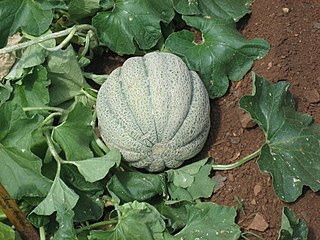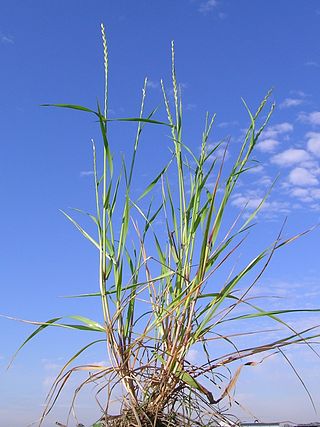
The Cucurbitaceae, also called cucurbits or the gourd family, are a plant family consisting of about 965 species in around 95 genera. Those most important to humans are the following:

The cucumber is a widely-cultivated creeping vine plant in the family Cucurbitaceae that bears cylindrical to spherical fruits, which are used as culinary vegetables. Considered an annual plant, there are three main types of cucumber—slicing, pickling, and seedless—within which several cultivars have been created. The cucumber originates in Asia extending from India, Nepal, Bangladesh, China, and Northern Thailand, but now grows on most continents, and many different types of cucumber are grown commercially and traded on the global market. In North America, the term wild cucumber refers to plants in the genera Echinocystis and Marah, though the two are not closely related.

A melon is any of various plants of the family Cucurbitaceae with sweet, edible, and fleshy fruit. The word "melon" can refer to either the plant or specifically to the fruit. Botanically, a melon is a kind of berry, specifically a "pepo". The word melon derives from Latin melopepo, which is the latinization of the Greek μηλοπέπων (mēlopepōn), meaning "melon", itself a compound of μῆλον (mēlon), "apple", treefruit " and πέπων (pepōn), amongst others "a kind of gourd or melon". Many different cultivars have been produced, particularly of cantaloupes.

Cucumis is a genus of twining, tendril-bearing plants in the family Cucurbitaceae which includes the cucumber, true melons, the horned melon, and the West Indian gherkin.

Coccinia grandis, the ivy gourd, also known as scarlet gourd, dhendura and kudri, is a tropical vine. It grows primarily in tropical climates and is commonly found in the Indian states where it forms a part of the local cuisine. Coccinia grandis is cooked as a vegetable dish.

The Armenian cucumber, Cucumis melo Flexuosus Group or Cucumis melo var. flexuosus, is a type of long, slender fruit which tastes like a cucumber and looks somewhat like a cucumber inside. It is actually a variety of true melon, a species closely related to the cucumber. It is also known as the yard-long cucumber, snake cucumber, snake melon, chanbar in Persian, tirozî in Kurdish, sheng in Semnani, uri in Japanese, acur in Turkish, kakadee in Hindi, tar in Punjabi, قثاء in Arabic, commarella or tortarello in Italian. It should not be confused with the snake gourds. The skin is very thin, light green, and bumpless. It has no bitterness and the fruit is almost always used without peeling. It is also sometimes called a gutah.

Citrullus colocynthis, with many common names including Abu Jahl's melon,colocynth, bitter apple, bitter cucumber, egusi, vine of Sodom, or wild gourd, is a desert viny plant native to the Mediterranean Basin and Asia, especially the Region of Palestine, Turkey, and Nubia.

The honeydew melon is one of the two main cultivar types in Cucumis melo Inodorus Group. It is characterized by the smooth, often green or yellowish rind and lack of musky odor. The other main type in the Inodorus Group is the wrinkle-rind casaba melon.

The citron melon, also called Citrullus lanatus var. citroides and Citrullus amarus, fodder melon, preserving melon, red-seeded citron, jam melon, stock melon, Kalahari melon or tsamma melon, is a relative of the watermelon. It is from the family Cucurbitaceae which consists of various squashes, melons, and gourds. Native to arid landscapes of sub-Saharan Africa, it has been a wild source of nutrition and hydration for humans for an extraordinarily long time. Its fruit has a hard white flesh, rendering it less likely to be eaten raw in the modern era; more often it is pickled or used to make fruit preserves, and is used for cattle feed. It is especially useful for fruit preserves, because it has a high pectin content.

Citrullus ecirrhosus, commonly known as Namib tsamma, is a species of perennial desert vine in the gourd family, Cucurbitaceae, and a relative of the widely consumed watermelon. It can be found in both Namibia and the Cape Provinces of South Africa, in particular the Namib Desert. It is the sister species to the bitter melon, Citrullus amarus with which it shares hard, white and bitter flesh.

Carthamus lanatus is a species of thistle known as woolly distaff thistle, downy safflower or saffron thistle. It is closely related to safflower. This annual plant is a native of the Mediterranean Basin, but it is familiar in other places where it was introduced and has become a noxious weed, such as in parts of North America and southern Australia with similar climates.

Watermelon is a flowering plant species of the Cucurbitaceae family and the name of its edible fruit. A scrambling and trailing vine-like plant, it is a highly cultivated fruit worldwide, with more than 1,000 varieties.

Cucurbitacins are a class of biochemical compounds that some plants – notably members of the pumpkin and gourd family, Cucurbitaceae – produce and which function as a defense against herbivores. Cucurbitacins and their derivatives have also been found in many other plant families, in some mushrooms and even in some marine mollusks.

Cucumis melo, also known as melon, is a species of Cucumis that has been developed into many cultivated varieties. The fruit is a pepo. The flesh is either sweet or bland, with or without a musky aroma, and the rind can be smooth, ribbed, wrinkled, or netted. In North America, the sweet-flesh varieties are often collectively called muskmelon, including the musky netted-rind varieties and the inodorous smooth-rind varieties, and cantaloupe usually refers to the former type. However, muskmelon in a narrow sense only refers to the musky netted-rind type, also known as North American cantaloupe, while the true cantaloupe is the European type with ribbed and often warty rind that is seldom grown in North America.
Paddy melon is a common name for two species of plants in the melon family which are invasive in Australia:
Wild melon is a common name used for several species of plants in the melon family (Cucurbitaceae) which grow outside of cultivation

Melon necrotic spot virus (MNSV) is a virus that belongs to the genus Gammacarmovirus of the family Tombusviridae. It has been observed in several countries of the Americas, Africa, Asia, and Europe. It is considered to be an endemic virus in greenhouses and field productions of Cucurbitaceae crops, including melon, cucumber, and watermelon. MNSV is mainly spread through infected soil, seedlings, insects, and by the root-inhabiting fungus vector Olpidium bornovanus. Symptoms vary between Curbitaceae crops, but generally consist of chlorosis, brown necrotic lesions, leaf wilt, fruit decay, and plant death. Management of the disease consists of preventing infection by rotating fields and crops, steam sterilization, and disposal of infected plants. Also, treated seeds with heat or chemicals are efficient in preventing infection. MNSV is important in melon plants as it causes vast economical damage worldwide reducing significant yields.

Lolium rigidum is a species of annual grass. Common names by which it is known include annual ryegrass, a name also given to Italian ryegrass, rigid ryegrass, stiff darnel, Swiss ryegrass and Wimmera ryegrass. It is a native of southern Europe, northern Africa, the Middle East and the Indian subcontinent and is grown as a forage crop, particularly in Australia, where it is also a serious and economically damaging crop weed.
Kalahari melon oil also known as Tsamma (Damara/Nama), wild watermelon (English), bitterboela, karkoer (Afrikaans), wild watermelon, makatane (Setswana) or Mokaté oil, is a plant oil, extracted from the seeds of the Kalahari melon (Citrullus vulgaris), which is endemic to the Kalahari Desert, spanning Namibia, Botswana and South Africa. Being one of 1,200 varieties of melon, Kalahari melon oil is distinct from regular watermelon seed oil. The seed of the Kalahari melon consists of approximately 50% oil, 35% protein and 5% dietary fibre.

Aulacophora foveicollis, the red pumpkin beetle, is a species of beetle in the family Chrysomelidae. It is a foliar pest of members of the Cucurbitaceae, particularly the pumpkin. It is also a pest of millets in India.


















